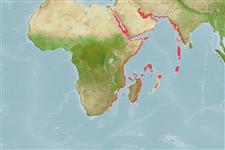>
Ovalentaria/misc (Various families in series Ovalentaria) >
Pomacentridae (Damselfishes) > Pomacentrinae
Etymology: Pomacentrus: Greek, poma, -atos = cover, operculum + Greek, kentron = sting (Ref. 45335).
More on author: Günther.
Environment: milieu / climate zone / depth range / distribution range
Ecología
marino asociado a arrecife; no migratorio; rango de profundidad 1 - 43 m (Ref. 7247). Tropical
Western Indian Ocean: Red Sea and the east African coast south to Natal, South Africa. Reported as likely to occur at Seychelles in Smith & Smith 1963 (Ref. 1623) but not listed as such in Allen 1991 (Ref. 7247).
Tamaño / Peso / Age
Maturity: Lm ? range ? - ? cm
Max length : 11.0 cm TL macho / no sexado; (Ref. 9710)
Espinas dorsales (total): 14; Radios blandos dorsales (total): 14-16; Espinas anales 2; Radios blandos anales: 15 - 17. Exhibits geographic color variations.
Adults inhabit inshore and offshore coral reefs (Ref. 7247). Oviparous, distinct pairing during breeding (Ref. 205). Eggs are demersal and adhere to the substrate (Ref. 205). Males guard and aerate the eggs (Ref. 205).
Life cycle and mating behavior
Madurez | Reproducción | Puesta | Huevos | Fecundidad | Larva
Oviparous, distinct pairing during breeding (Ref. 205). Eggs are demersal and adhere to the substrate (Ref. 205). Males guard and aerate the eggs (Ref. 205).
Allen, G.R., 1991. Damselfishes of the world. Mergus Publishers, Melle, Germany. 271 p. (Ref. 7247)
IUCN Red List Status (Ref. 130435)
Threat to humans
Harmless
Human uses
Pesquerías: sin interés
Más información
ReferenciasAcuiculturaPerfil de acuiculturaRazasGenéticaElectrophoresesheritabilidadEnfermedadesProcesamientoNutrientsMass conversion
Herramientas
Special reports
Download XML
Fuentes de Internet
Estimates based on models
Preferred temperature (Ref.
123201): 24.7 - 29.3, mean 27.2 °C (based on 258 cells).
Phylogenetic diversity index (Ref.
82804): PD
50 = 0.5000 [Uniqueness, from 0.5 = low to 2.0 = high].
Bayesian length-weight: a=0.02399 (0.01139 - 0.05051), b=2.98 (2.81 - 3.15), in cm total length, based on LWR estimates for this Genus-body shape (Ref.
93245).
Nivel trófico (Ref.
69278): 2.7 ±0.30 se; based on food items.
Resiliencia (Ref.
120179): Alto, población duplicada en un tiempo mínimo inferior a 15 meses (Preliminary K or Fecundity.).
Fishing Vulnerability (Ref.
59153): Low vulnerability (10 of 100).
Nutrients (Ref.
124155): Calcium = 109 [55, 167] mg/100g; Iron = 0.758 [0.467, 1.242] mg/100g; Protein = 18.2 [17.0, 19.3] %; Omega3 = 0.119 [0.072, 0.189] g/100g; Selenium = 26.4 [14.8, 48.2] μg/100g; VitaminA = 86.1 [23.5, 292.2] μg/100g; Zinc = 1.75 [1.20, 2.53] mg/100g (wet weight);
